Eugene Cernan
| Eugene Cernan | |
|---|---|
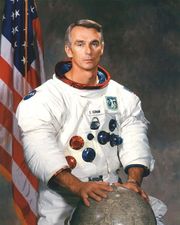 |
|
| NASA Astronaut | |
| Nationality | American |
| Status | Retired |
| Other occupation | Fighter pilot |
| Rank | Captain, USN |
| Time in space | 23d 14h 15m |
| Selection | 1963 NASA Group |
| Missions | Gemini 9A, Apollo 10, Apollo 17 |
| Mission insignia |
|
Eugene "Gene" Andrew Cernan (born March 14, 1934) is a retired United States Navy officer and a former NASA astronaut and engineer. He has been into space three times: as co-pilot of Gemini 9A in June 1966; as lunar module pilot of Apollo 10 in May 1969; and as commander of Apollo 17 in December 1972. In that final lunar landing mission, Cernan became "the last man on the moon" since he was the last to re-enter the Apollo Lunar Module during its third and final extra-vehicular activity (EVA). (While crewmate Harrison Schmitt was "the last man to arrive on the moon" as Cernan left the module first). Cernan was also a backup crew member for the Gemini 12, Apollo 7 and Apollo 14 missions.
Contents |
Biography
A native of Chicago, Illinois, son of a Czech mother and a Slovak father, he received his father's name, originally spelled Ondrej Čerňan (IPA: [ˈondrɛj ˈtʃɛrɲan]). Cernan grew up in the towns of Bellwood and Maywood, a largely African-American community. He graduated from Proviso East High School in Maywood, Illinois and Purdue University, where he became a member of Phi Gamma Delta, in 1956, with a B.S. in Electrical Engineering. He was commissioned into the United States Navy through the Naval Reserve Officers Training Corps at Purdue, and became a Naval Aviator flying jets. He also received a M.S. in Aeronautical Engineering from the Naval Postgraduate School in 1963. In 1976, Cernan retired both from the Navy (as a Captain) and from NASA, and went into private business.
NASA career
Cernan was selected among the third group of NASA astronauts in October 1963 by the National Aeronautics and Space Administration (NASA) to participate in Projects Gemini and Apollo.
Gemini Program
Cernan was originally selected as back-up pilot for Gemini IX with Thomas Stafford but when the prime-crew was killed in a plane crash they became the prime crew. Gemini 9A encountered a number of problems; the original target vehicle exploded and the planned docking was made impossible by a protective shroud failing to eject. Cernan performed the second American EVA (only the third ever) but his space suit overheated resulting in a very high heart rate. The crew performed a demonstration of an early rendezvous that would be used in Apollo 10: the first optical rendezvous; and a lunar orbit abort rendezvous.
Apollo Program
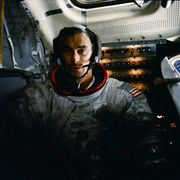
Cernan is one of only three humans to voyage to the moon on two different occasions (the others being Jim Lovell and John Young), one of only twelve people to walk on the moon and the only person to have descended to the moon in the lunar-lander twice (of which the first was a non-landing test mission). Cernan orbited the moon on Apollo 10, and landed on the moon on Apollo 17.
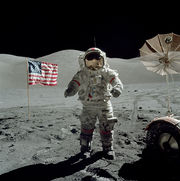
While on the moon during Apollo 17, he and his crewmate Harrison Schmitt performed three EVAs for a total of about 22 hours of exploration. Their first EVA alone was over three times the length Neil Armstrong and Buzz Aldrin spent outside the LM on Apollo 11. During this time they covered over 35 km (22 mi) using the Lunar Rover and spent a great deal of time collecting geologic samples that would shed light on the moon's early history. Cernan piloted the Rover on its final sortie, recording a maximum speed of 11.2 mph (18.0 km/h), giving him the (unofficial) lunar land speed record.[1]
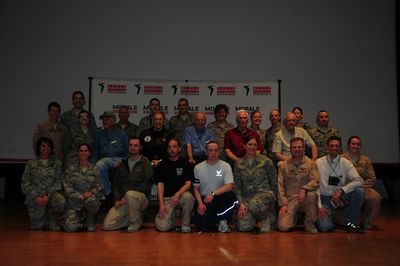
As Cernan got ready to climb the ladder he spoke these words, the last currently spoken by a human standing on the moon's surface: "As we leave the Moon at Taurus-Littrow, we leave as we came, and God willing, as we shall return, with peace and hope for all mankind. As I take these last steps from the surface for some time to come, I'd just like to record that America's challenge of today has forged man's destiny of tomorrow. Godspeed the crew of Apollo Seventeen." [1]
Cernan turned down the opportunity to walk on the moon 8 months earlier as Lunar Module Pilot of Apollo 16 preferring to risk missing a flight altogether for the opportunity to command his own mission. Cernan was publicly critical of the decision by NASA to send a scientist - Harrison Schmitt - to the moon, a decision that meant that original Lunar Module Pilot Joe Engle never got to walk on the moon. However, in Cernan's words, he proved a capable LM Pilot.
Before leaving the moon for the last time, Cernan etched his daughter’s initials into the lunar dust. Because there is no weather on the moon, it will stay there indefinitely.
Cernan's distinction as the last person to walk on the moon meant that Purdue University would hold the distinction of being the alma mater of both the first person to walk on the moon (Neil Armstrong) and the last person to walk on the moon (Cernan).
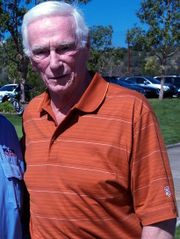
Post-NASA
In 2009, Cernan co-authored The Last Man on the Moon with Don Davis. The book contains his memoirs of his career both with NASA and before. He has also been featured in space exploration documentaries, such as In the Shadow of the Moon, in which he stated: "Truth needs no defense" and "nobody can take those footsteps I made on the surface of the moon away from me."[2] Cernan also contributed to the book of the same name.
He is featured in the Discovery Channel's documentary miniseries When We Left Earth, providing narrative on his involvement and missions as an astronaut.
In the 1998 miniseries From the Earth to the Moon, Cernan was played by Daniel Hugh Kelly. Cernan also at one time was a contributor to ABC News and its Good Morning America morning show.
His recollections were the basis of the song "Moon Rider", written by Paul and Ralph Colwell and Herbert Allen, performed by Up With People.
On May 13, 2010, Cernan and Neil Armstrong appeared before congress to argue to for a return mission to the moon and further space exploration in the face of proposed cuts to NASA'a manned flight programs.
References
- ↑ Lyons, Pete. "10 Best Ahead-of-Their-Time Machines", in Car and Driver, 1/88, p.78. As of 1 March 2010, no challenge has been announced.
- ↑ Soller, Kurt (2009-07-17), "Moonstruck: Debunking the Claims of Moon Landing Deniers", Newsweek, http://www.newsweek.com/id/207149, retrieved 2009-09-04
See also
- Cernan Earth and Space Center, a public planetarium on the campus of Triton College in River Grove, Illinois that is named in Captain Cernan's honor.
External links
- The Official Website of Capt. Eugene Cernan
- Biographical data from US National Aeronautics and Space Administration
- Last Man on the Moon
- Gene Cernan flies the Windows-based "Eagle Lander 3D" Simulator
- Eugene Cernan interview on The Sky at Night (BBC, 29 min, RealPlayer)
- Check-Six.com - The 1971 Crash of Gene Cernan's Helo
|
|||||
|
|||||||||||||